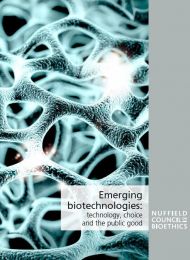Emerging biotechnologies: technology, choice and the public good
Report
Published 13/12/2012

Biotechnologies are significant in many aspects of life, from food and energy production to medicine, industry, and economic development.
Emerging biotechnologies differ considerably in nature and purpose, but some common features in the way they evolve can be identified.
The term ‘biotechnology’ is used to apply to many different kinds of thing, including the following:
- a broad field of knowledge (such as synthetic biology);
- a programme of research (such as genetic modification of crops);
- a specific technique (such as DNA sequencing);
- an application of a technique (such as in vitro fertilisation);
- a product (such as a nanoscale biosensor device).
We characterise the emergence of a biotechnology as a process of bringing together knowledge, practices, products and applications into viable and productive relationships. The types of technologies that are considered in the report all involve the use, modification or creation of a biological system or process.
- Emerging biotechnologies are unlike established biotechnologies in that they are particularly sensitive to contextual factors that can shape their evolution, including those that can ‘lock in’ or ‘crowd out’ certain possibilities.
- Emerging biotechnologies are distinguished from other emerging technologies by the fact that they utilise or affect living things, and therefore engage the public interest in distinctive ways.
Examples of key areas in which significant advances are currently taking place include:
- cellular biotechnologies, including regenerative medicine;
- molecular biotechnologies, including transgenic plants and animals, and pharmaceutical biotechnology;
- genomic medicine, including personalised medicine, gene therapy and bioinformatics;
- synthetic biology, including novel engineered machines and organisms;
- nanotechnologies and nanomedicine [Chapter 2].

Share